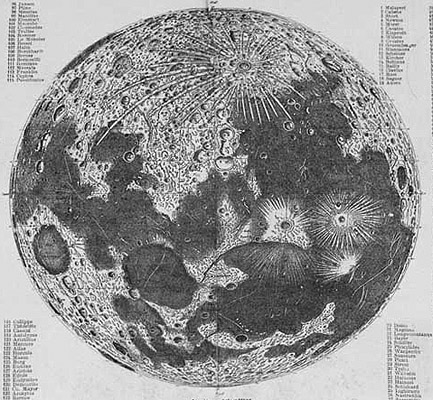Difference between revisions of "January 21, 2012"
| Line 2: | Line 2: | ||
=French Moon= | =French Moon= | ||
<!-- ws:start:WikiTextHeadingRule:0:<h1> --> | <!-- ws:start:WikiTextHeadingRule:0:<h1> --> | ||
| + | <table class="wiki_table"> | ||
| + | <tr> | ||
| + | <td><!-- ws:start:WikiTextLocalImageRule:14:<img src="/file/view/LPOD-2004-01-20.jpg/294032736/LPOD-2004-01-20.jpg" alt="" title="" /> -->[[File:LPOD-2004-01-20.jpg|LPOD-2004-01-20.jpg]]<!-- ws:end:WikiTextLocalImageRule:14 --><br /> | ||
| + | </td> | ||
| + | <td><em>image from [mailto:tychocrater@yahoo.com Chuck Wood]</em><br /> | ||
| + | <br /> | ||
| + | <strong>This was [http://www.lpod.org/archive/archive/2004/01/LPOD-2004-01-20.htm LPOD] 8 years and one day ago. After a Google search it is disappointing that a better version of this forgotten map is still not available.</strong><br /> | ||
| + | <br /> | ||
| + | Classical studies of the Moon from the late 1700s and 1800s were most famously done in Germany (Schroter, Lohrmann, Beer and Madler and Schmidt (who did much work in Athens). From 1876 (Neison and then Elger and Goodacre) to 1955 (Wilkins and Moore), England was the center of lunar mapping. What about other nations? Through the inspiration of famed astronomy popularizer Camille Flammarion (1842-1925), French lunar studies spread to Delmotte, Lamech and culminated in Liscardy's massive <em>Atlas-Guide de la Lune</em>. Flammarion was the David Levy of his day - a tireless observer and passionate advocate for astronomy. This chart of the Moon (drawn by Lecouturier and Chapuis) appeared in the 1881 edition of Flammarion's book <em>Astronomie Populaire</em>. The map shows a certain flamboyant simplicity and Italian influence (spaghetti-like rays from Tycho)!<br /> | ||
| + | <br /> | ||
| + | <em>[mailto:tychocrater@yahoo.com Chuck Wood]</em><br /> | ||
| + | <br /> | ||
| + | <strong>Related Links:</strong><br /> | ||
| + | [http://www.culture.gouv.fr/culture/flammarion/accueil/index1.htm L'observatoire de C. Flammarion] (in French)<br /> | ||
| + | [http://en.wikipedia.org/wiki/Camille_Flammarion Flammarion] (in English)<br /> | ||
| + | <br /> | ||
| + | <p><b>Yesterday's LPOD:</b> [[January 20, 2012|Meow Rilles]] </p> | ||
| + | <p><b>Tomorrow's LPOD:</b> [[January 22, 2012|The Dawn of Walther]] </p> | ||
| + | <hr /> | ||
| + | <!-- ws:start:WikiTextHeadingRule:2:<h3> --><h3 id="toc1"><!-- ws:end:WikiTextHeadingRule:2 -->COMMENTS?</h3> | ||
| + | Click on this icon <!-- ws:start:WikiTextLocalImageRule:15:<img src="/file/view/PostIcon.jpg/293056078/PostIcon.jpg" alt="" title="" /> -->[[File:PostIcon.jpg|PostIcon.jpg]]<!-- ws:end:WikiTextLocalImageRule:15 --> at the upper right to post a comment.<br /> | ||
| + | <br /> | ||
| + | <hr /> | ||
| + | <!-- Removed reference to store page --> | ||
| + | </td> | ||
| + | </tr> | ||
| + | </table> | ||
{{wiki/ArticleFooter}} | {{wiki/ArticleFooter}} | ||
Revision as of 12:31, 7 February 2015
French Moon
 |
image from Chuck Wood
Yesterday's LPOD: Meow Rilles Tomorrow's LPOD: The Dawn of Walther COMMENTS?Click on this icon PostIcon.jpg at the upper right to post a comment. |
COMMENTS?
Register, Log in, and join in the comments.



